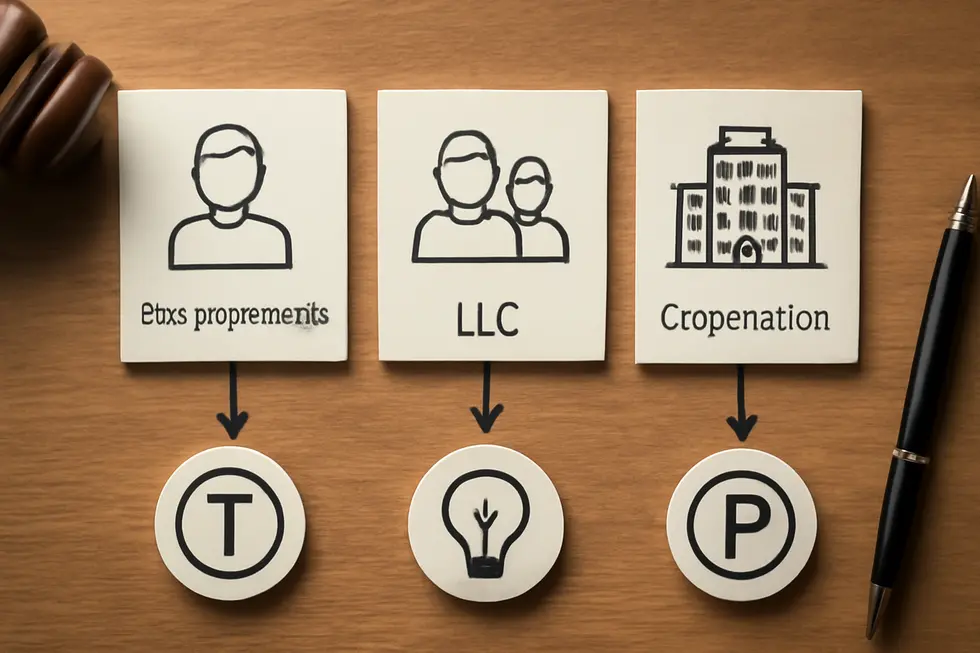Introduction
Intellectual property (IP) is a cornerstone asset for any business, representing the creative ideas, innovations, and brands that differentiate companies in competitive markets. Owning the rights to your IP means having control over these intangible yet invaluable resources to fuel growth, generate revenue, and safeguard your competitive edge. From patents and trademarks to copyrights and trade secrets, understanding the types of intellectual property and how ownership is legally established can empower you to make informed strategic decisions. This guide breaks down the essential facets of intellectual property ownership: beginning with defining the types of IP commonly encountered, moving into how ownership is legally assigned through agreements, examining the impact of business structures on rights management, outlining protection and enforcement mechanisms, exploring how IP ownership translates into licensing and transactions, and finally addressing the complexities of joint ownership and partnerships. Each chapter builds a comprehensive framework to help you navigate the complexities of intellectual property with confidence and clarity, ensuring you maximize its value and avoid costly disputes.
Tables of Contents
Chapter 1: Types of Intellectual Property Ownership: Patents, Trademarks, Copyrights, and Trade Secrets
- The Vital Role of Patents in Defining Intellectual Property Ownership and Innovation
- The Critical Role of Trademarks in Defining and Protecting Brand Ownership
- Navigating the Economic and Legal Landscape of Copyright and Trade Secret Ownership
Chapter 2: Establishing Intellectual Property Ownership through Agreements and Assignments
- Securing Employer Rights: How Employment Agreements Define Intellectual Property Ownership
- Navigating IP Ownership in Strategic Partnerships: Defining Rights and Contributions
- Navigating Joint Ownership and Assignment Agreements: Foundations for Clear Intellectual Property Rights
Chapter 3: Legal Structures and Their Impact on Intellectual Property Ownership
- Navigating Technological Shifts: Legal Challenges Shaping Intellectual Property Ownership
- How Legal Frameworks Shape Economic Value and Control of Intellectual Property
- How Geopolitical and Societal Forces Shape Intellectual Property Laws and Ownership
Chapter 4: Protection and Enforcement Mechanisms in Intellectual Property Ownership
- Navigating Legal Remedies and Frameworks to Enforce Intellectual Property Rights
- Harnessing Digital Innovations for Effective Intellectual Property Protection and Enforcement
- Leveraging Contractual Frameworks and Trade Secret Management to Secure Intellectual Property Rights
Chapter 5: Strategic Management of Intellectual Property in Business Transactions and Licensing
- Navigating Ownership and Control in Intellectual Property Deals for Revenue Growth
- Balancing Control and Profit: Strategic Licensing and Financial Models in Intellectual Property Ownership
- Crafting Legal Agreements to Unlock Revenue Potential in Intellectual Property Transactions and Licensing
Chapter 6: Partnerships and Joint Intellectual Property Ownership: Agreements and Dispute Prevention
- Crafting Effective Ownership Clauses to Navigate Joint Intellectual Property Rights and Avoid Conflicts
- Balancing Usage Rights and Decision Authority to Strengthen Joint IP Partnerships
- Crafting Clear Agreements and Effective Resolution Pathways for Joint Intellectual Property Partnerships
Chapter 1: Types of Intellectual Property Ownership: Patents, Trademarks, Copyrights, and Trade Secrets

1. The Vital Role of Patents in Defining Intellectual Property Ownership and Innovation
Patents grant inventors exclusive rights to their inventions for about 20 years, protecting new and useful products or processes from unauthorized use. This legal ownership enables inventors and companies to control manufacturing, selling, or importing their patented technologies, supporting innovation by allowing them to recover development costs. Patents can be owned individually or jointly, and ownership is transferable through formal assignments, which must be properly recorded to maintain legal effect. Unlike trademarks or copyrights, patents have a limited term but cover technical inventions such as machinery, chemical compounds, or software algorithms. Effective patent ownership management, especially in collaborations, requires clear contracts to prevent disputes and maximize value. Patents create significant strategic and financial benefits by securing a competitive edge and enabling licensing opportunities. They stand alongside trademarks, copyrights, and trade secrets as essential components of intellectual property ownership, each providing unique protections tailored to different kinds of creative and commercial assets. For more detailed insight on patent ownership and related agreements, consulting specialized resources is advisable, such as the guidance found at trademark2go.com/company-intellectual-property-protection.
2. The Critical Role of Trademarks in Defining and Protecting Brand Ownership
Trademarks serve as vital identifiers that distinguish a business’s products or services from competitors, embodying brand reputation and consumer trust. Unlike patents or copyrights, trademarks protect distinct signs such as logos, names, slogans, colors, and even sounds, which signal the source of goods in commerce. Ownership of trademarks is established primarily through registration with the U.S. Patent and Trademark Office (USPTO), granting exclusive nationwide rights and clear legal protections against unauthorized use. While unregistered or common-law trademarks can offer limited protection based on actual use in commerce, registration strengthens an owner’s ability to enforce rights, including suing for infringement or blocking counterfeit products. Holding trademarks as intellectual property offers companies strategic value, reinforcing brand identity and market position. This protection mechanism plays a crucial role within the broader spectrum of IP ownership structures, linking brand assets directly to business value and ensuring control over how these identifiers are used and shared. For a deeper understanding of trademark protections, see the detailed explanation on common law trademark rights.
3. Navigating the Economic and Legal Landscape of Copyright and Trade Secret Ownership
Copyrights and trade secrets hold distinctive economic and legal significance within intellectual property ownership. Copyrights grant creators exclusive control over their original works like literature, software, or films, enabling monetization through licensing and sales. This exclusivity fuels innovation and cultural growth, generating billions annually in economic value. Trade secrets protect critical business information indefinitely, as long as confidentiality is maintained, offering businesses a sustained competitive advantage. However, trade secret ownership demands proactive secrecy measures, making enforcement intricate, especially when collaborations or employee departures occur. Legally, copyrights endure for the author’s lifetime plus 70 years, providing long-term security, but digital enforcement challenges persist. Structuring ownership through entities like LLCs can optimize management, liability protection, and tax benefits for these assets. Co-ownership situations further complicate control and licensing, requiring clear agreements to prevent disputes. Understanding these dynamics is essential for leveraging these IP types effectively within broader ownership strategies. For a deeper understanding of copyright nuances in business, exploring detailed copyright information tailored for businesses is recommended.
Chapter 2: Establishing Intellectual Property Ownership through Agreements and Assignments

1. Securing Employer Rights: How Employment Agreements Define Intellectual Property Ownership
Employment agreements serve as a critical instrument in securing intellectual property (IP) ownership for employers. These contracts typically include explicit IP assignment clauses requiring employees to transfer rights to any creations developed within their employment scope. Without such agreements, default legal rules often favor the creator, making ownership uncertain. This is especially vital in industries driven by innovation, where inventions and creative works emerge daily. For independent contractors, the “work for hire” doctrine applies more narrowly—requiring clear written terms to transfer IP ownership. Invention assignment agreements within employment contracts usually specify definitions, scope, and confidentiality measures to safeguard the employer’s interests. These provisions help prevent costly disputes by clarifying ownership upfront, ensuring companies maintain control over their valuable intellectual assets. Clear employer-employee IP arrangements are thus fundamental to comprehensive IP management strategies. For an in-depth exploration of copyright fundamentals that complement employer agreements, see this guide on copyright language for business owners.
2. Navigating IP Ownership in Strategic Partnerships: Defining Rights and Contributions
Strategic partnership agreements serve as a fundamental framework for clearly establishing intellectual property ownership between collaborators. These agreements meticulously distinguish between background IP—assets each party brings to the table—and newly developed IP, setting explicit terms for ownership and usage. Ownership allocation often reflects each partner’s contributions, whether financial, technological, or personnel-based, allowing for proportional or specially negotiated shares. Careful due diligence prior to agreement finalization ensures verified ownership and uncovers potential risks, aligning the partnership’s IP management with broader business goals. Agreements also anticipate future innovations, embedding flexibility to adjust ownership and licensing terms as the partnership evolves. Formalizing all terms within an Intellectual Property Rights Agreement (IPRA) safeguards proprietary innovations by defining rights, usage permissions, and protections against infringement or misuse. This strategic clarity prevents disputes and fosters trust, enabling partners to capitalize on their joint intellectual assets with confidence. For more insights on protecting creative works in business, see copyright information example for business.
3. Navigating Joint Ownership and Assignment Agreements: Foundations for Clear Intellectual Property Rights
Joint ownership arises when multiple parties collaborate to create intellectual property (IP). Without clear, written agreements, default legal rules may apply, often causing ambiguity about rights to use, license, or transfer the IP. Establishing explicit ownership arrangements upfront is essential to address who holds rights—whether sole, joint, or licensed ownership—and to define the scope of usage rights, such as exclusivity or territorial limits. Assignment agreements complement joint ownership by formally transferring IP rights, detailing the parties involved and the terms of transfer, which are critical in employment settings to secure a company’s claim on employee-created IP. Effective agreements also anticipate partnership changes through exit clauses that govern division or buyouts of IP assets. Careful drafting safeguards against disputes and ensures that all contributors understand their rights and obligations, preserving innovation value. For businesses managing collaborations, reviewing existing contractual restrictions like anti-assignment clauses is vital to avoid unintended breaches and protect confidential information throughout development phases. This comprehensive approach creates a strong foundation for managing joint intellectual property within complex collaborative environments.
Chapter 3: Legal Structures and Their Impact on Intellectual Property Ownership

1. Navigating Technological Shifts: Legal Challenges Shaping Intellectual Property Ownership
The rapid rise of artificial intelligence and digital technologies is fundamentally reshaping how legal structures govern intellectual property (IP) ownership. Traditional IP laws generally recognize humans as inventors or authors, creating uncertainty around AI-generated creations. This gap prompts ongoing debate, as seen in jurisdictions like South Africa that controversially recognize AI as inventors, contrasting with many countries that insist on human attribution. These shifts demand modernization of patent and copyright frameworks to clarify ownership, protect rights, and address enforcement challenges.
The complexity of managing IP in technology-intensive fields has led to denser patent landscapes and evolving licensing models, including patent pools and standardized agreements. Legal expertise must now integrate deep technological understanding, especially regarding AI governance and cybersecurity, to guide protection strategies effectively. Additionally, global variations in IP recognition complicate ownership claims, necessitating cross-jurisdictional navigation.
Emerging technologies also influence IP valuation and transactions, with tools like predictive analytics transforming due diligence. These technological dimensions compel legal structures to adapt, ensuring that ownership models remain robust and effective in the digital era.
2. How Legal Frameworks Shape Economic Value and Control of Intellectual Property
The economic value of intellectual property (IP) is deeply influenced by the underlying legal structures that govern ownership and enforcement. Jurisdictions with adaptable legal systems that protect individual and corporate property rights foster stronger IP regimes, encouraging innovation and investment. Robust legal frameworks enable companies to leverage IP as critical economic assets, securing market exclusivity and enhancing competitive advantage through licensing, mergers, and acquisitions. Conversely, jurisdictions with rigid or unstable legal traditions can undermine IP’s economic potential by weakening enforcement and deterring investment. Emerging technologies, such as artificial intelligence, demand flexible legal strategies to balance protection with innovation. Maintaining predictable and stable legal environments is essential not only for safeguarding IP ownership but also for stimulating sustained economic growth. This dynamic highlights how the interplay between law and economics is central to maximizing IP’s commercial and strategic benefits.
3. How Geopolitical and Societal Forces Shape Intellectual Property Laws and Ownership
Legal frameworks for intellectual property ownership are profoundly shaped by geopolitical and societal forces that reflect national priorities and global power shifts. Governments increasingly view IP not just as private property but as strategic assets vital to national security and economic sovereignty. Rising nationalism and protectionism drive policies that prioritize control over key technologies, sometimes undermining global IP enforcement consistency. Societal factors—such as political stability and regulatory quality—further influence IP regimes; unstable political climates often deter innovation and foreign investment by creating risks of expropriation or forced technology transfers. The ongoing US-China rivalry over AI and semiconductors exemplifies how IP ownership intersects with geopolitical tensions, with each nation crafting laws to protect domestic innovations and restrict technology access. These dynamics impact where companies locate research and affect global innovation flows. Understanding these geopolitical and societal influences is crucial to navigating the complex terrain of IP ownership today and anticipating future challenges in legal protection and enforcement. For practical guidance on protecting brand-related IP, exploring trademark frameworks can be insightful.
Chapter 4: Protection and Enforcement Mechanisms in Intellectual Property Ownership

1. Navigating Legal Remedies and Frameworks to Enforce Intellectual Property Rights
Effective protection of intellectual property (IP) ownership relies on comprehensive legal frameworks combining civil, criminal, and administrative remedies. These frameworks empower rights holders to enforce their ownership through monetary damages, injunctive relief to halt infringements, and court orders for seizure or destruction of counterfeit products. Declaratory judgments clarify ownership disputes, while accounting for profits compels infringers to surrender unlawful earnings. Severe violations may attract criminal penalties such as fines and imprisonment, and border enforcement by customs officials prevents the importation of infringing goods.
While enforcement laws vary globally, international treaties support cross-border cooperation essential to combating IP violations. In the United States, federal statutes govern patent disputes, often resolved in specialized courts, with legal strategies like cease-and-desist letters utilized pre-litigation. For businesses protecting intangible assets, contractual agreements including confidentiality and licensing clauses complement statutory protections, safeguarding innovations and brand identity.
Addressing emerging challenges such as AI-driven inventions necessitates adaptive legal approaches integrating regulatory compliance and collaboration between technical and legal teams to maintain robust IP protection. For more on trademark defenses within IP ownership, review this insight on trademark protection for business names and logos.
2. Harnessing Digital Innovations for Effective Intellectual Property Protection and Enforcement
Harnessing Digital Innovations for Effective Intellectual Property Protection and Enforcement
In the evolving digital landscape, innovative technologies have become essential in safeguarding intellectual property (IP). Artificial intelligence-powered monitoring tools continuously scan online platforms and marketplaces, detecting unauthorized use of trademarks, copyrights, and counterfeit goods in real time. This proactive surveillance enables prompt intervention before infringements escalate. Blockchain technology further strengthens IP protection by providing secure, immutable records that authenticate ownership and prove provenance, streamlining dispute resolution and enabling automated contract enforcement.
Complementing these are digital rights management (DRM) systems, which leverage automation to track and control the use and distribution of copyrighted works. Social media and e-commerce platforms enhance trademark enforcement by integrating reporting tools and AI detection, helping brands identify fake accounts and unauthorized sales quickly. Moreover, legal technology supports streamlined issuance of cease-and-desist notices and litigation assistance, reducing barriers especially for smaller creators.
Engaging communities online also promotes vigilance against counterfeits, fostering collective protection. As AI-generated content challenges traditional IP frameworks, ongoing advancements in policy and tools strive to address these complexities. Together, these digital innovations form a robust ecosystem that amplifies legal protections, ensuring intellectual property rights are actively monitored, authenticated, and enforced.
For insight into managing copyrights effectively, see detailed guidance on copyright language for business owners.
3. Leveraging Contractual Frameworks and Trade Secret Management to Secure Intellectual Property Rights
Effectively protecting intellectual property ownership demands a strategic blend of robust contractual frameworks and diligent trade secret management. Contracts such as Intellectual Property Rights Agreements, Non-Disclosure Agreements, and employment contracts explicitly define ownership claims, usage rights, and confidentiality obligations, establishing clear legal grounds for enforcement. These agreements not only prevent unauthorized exploitation but also provide recourse if breaches occur.
Parallel to contracts, trade secret strategies focus on the operational control of sensitive information, ensuring it remains confidential throughout its lifecycle. Organizations classify proprietary data by sensitivity and implement strict access controls, encryption, and secure storage measures. Regular audits and employee training reinforce these safeguards, further mitigating risks of accidental or intentional disclosure.
Enforcement bridges legal claims with practical actions—preserving evidence, revoking access, and conducting internal investigations—enhancing the defense against infringement. Emerging challenges, particularly those arising from digital transformation and AI transparency demands, require adaptive measures in both contract design and confidential data protection. Together, these approaches form a resilient system that secures intellectual property through legal clarity and vigilant operational oversight.
For deeper insights on contractual protections in copyrights, see the detailed discussion on copyright contracts for business owners.
Chapter 5: Strategic Management of Intellectual Property in Business Transactions and Licensing

1. Navigating Ownership and Control in Intellectual Property Deals for Revenue Growth
Ownership of intellectual property (IP) is essential when engaging in transactions, licensing, and revenue generation. In deals such as mergers or acquisitions, it is vital to verify the legal ownership of patents, trademarks, copyrights, and trade secrets to confirm that the rights are transferable and free from encumbrances. IP ownership in transactions often involves permanent assignments or licensing agreements; the latter allows licensors to retain control while monetizing through royalties or milestone payments. Licensing terms define scope, duration, exclusivity, and territorial rights, balancing control with revenue objectives. However, IP’s intangible nature and susceptibility to rapid obsolescence require careful due diligence. Protecting trade secrets demands ongoing confidentiality measures, while contracts must establish clear enforcement provisions and dispute resolution processes. Effective IP management in transactions and licensing maximizes value and mitigates risks by aligning ownership control with strategic business goals. For further insight on trademark considerations within IP ownership, see trademark protection for business names and logos.
2. Balancing Control and Profit: Strategic Licensing and Financial Models in Intellectual Property Ownership
Licensing intellectual property blends strategic control with effective monetization, enabling owners to generate revenue while preserving their core rights. Agreements commonly distinguish between exclusive licensing, granting sole usage rights often paired with premium royalties, and non-exclusive licenses that broaden market reach through multiple licensees. Carefully crafted clauses regulate sublicensing and transfers to ensure licensors retain oversight, preventing unauthorized expansion of rights or dilution of IP value. Financially, royalty structures adapt to business objectives with models including fixed percentages on gross sales, tiered rates rewarding higher sales volumes, and milestone payments tied to key achievements like regulatory approvals. Profit-sharing arrangements further align incentives, fostering collaboration with transparent accounting. Modern revenue management increasingly leverages automation—blockchain and smart contracts enhance transparency and streamline royalty distributions across jurisdictions. This integration of legal precision and flexible financial approaches transforms intellectual property into scalable, reliable cash flow sources, crucial for sustained growth and protection of intangible assets. For a deeper understanding of IP protections relevant to revenue strategies, explore trademark and copyright basics.
3. Crafting Legal Agreements to Unlock Revenue Potential in Intellectual Property Transactions and Licensing
Legal agreements form the cornerstone of leveraging intellectual property (IP) ownership for revenue generation. These contracts clearly define ownership rights, usage permissions, financial arrangements, and exit provisions, enabling parties to protect their assets while maximizing economic returns. Ensuring clarity on whether IP is solely owned, jointly held, or licensed is vital to avoid disputes and streamline commercial use. Licensing agreements, tailored with exclusive, sole, or non-exclusive rights, specify boundaries like geography, duration, and usage scope, aligning expectations between licensors and licensees. Financial terms often incorporate royalties—ranging from fixed fees to tiered or milestone-based payments—that incentivize performance without compromising control. Additionally, well-crafted exit clauses safeguard IP value during transitions such as buyouts or mergers. In mergers and acquisitions, IP represents a strategic asset that can enhance valuation and create ongoing revenue streams. Integrating such agreements thoughtfully ensures that intellectual property not only remains protected but also becomes a robust engine for sustained profitability. For deeper insight on structuring effective IP agreements, see this detailed guide on structuring licensing deals to retain control over core IP assets.
Chapter 6: Partnerships and Joint Intellectual Property Ownership: Agreements and Dispute Prevention

1. Crafting Effective Ownership Clauses to Navigate Joint Intellectual Property Rights and Avoid Conflicts
Clear ownership clauses are the cornerstone of successful partnerships involving joint intellectual property (IP). These agreements must explicitly define who owns the IP created during collaboration—whether ownership is sole, joint, or licensed—and establish how rights are shared. Without such clarity, default rules may lead to co-ownership, complicating licensing, enforcement, or commercialization. Typically, joint ownership grants each partner usage rights but requires mutual consent for licensing or sale, necessitating careful coordination.
To minimize disputes, agreements often specify usage parameters, territorial or field exclusivity, and detailed exit strategies such as buyouts or IP transfer procedures if the partnership dissolves. Including mechanisms for dispute resolution further protects all parties’ interests. For patent ownership especially, these provisions clarify contributions, licensing rights, and profit sharing, reducing costly conflicts and maximizing returns.
In addition, well-drafted IP agreements commonly integrate confidentiality clauses, representations on IP validity, and termination terms. These elements collectively ensure robust protection, streamlined collaboration, and preparedness for potential challenges. Thoughtful ownership clauses thus safeguard valuable intangible assets created through partnership efforts.
For more detailed guidance on structuring IP ownership agreements in partnerships, see the resource on best practices for assigning IP ownership.
2. Balancing Usage Rights and Decision Authority to Strengthen Joint IP Partnerships
In joint intellectual property ownership, clarity around usage rights and decision-making authority is crucial to maintain trust and prevent conflicts. Effective agreements explicitly define each partner’s rights to use, license, or commercialize the jointly owned IP, ensuring contributions are respected and benefits fairly distributed. Decision-making structures categorize choices by their impact—routine management may be delegated to one partner, while major decisions like licensing or litigation typically require unanimous or majority approval. Including dispute resolution methods, such as mediation or arbitration, further protects the partnership by minimizing costly legal battles.
Financial terms must align with contributions, covering revenue sharing, profit allocation, and responsibility for expenses. The agreement should also detail procedures for admitting new partners and amending terms to accommodate evolving business needs. Restrictive covenants safeguard confidential information and competitive interests, especially if partners depart. By integrating these elements into comprehensive agreements, partners ensure smooth collaboration and sustained innovation. For guidance on protecting visual brand elements within partnerships, see more on trademark protection for business names and logos.
3. Crafting Clear Agreements and Effective Resolution Pathways for Joint Intellectual Property Partnerships
Crafting clear agreements in partnerships with joint intellectual property (IP) ownership is essential to prevent and resolve disputes efficiently. Such agreements must explicitly define partner roles, ownership shares, decision-making authority, and responsibilities related to IP management. Detailing dispute resolution procedures creates a structured pathway that prioritizes negotiation and mediation, helping partners maintain collaboration and confidentiality. When confusion arises, mediation offers a neutral ground to find mutually acceptable solutions, while arbitration provides a binding but less adversarial alternative to litigation, which remains a last resort. Preventive measures like regular IP audits and partner education on rights reinforce clarity and reduce risk. In cross-border partnerships, alternative dispute resolution frameworks, supported by international treaties, enhance enforceability and global cooperation. By integrating these mechanisms into partnership and IP ownership agreements, parties can safeguard their creative assets and foster sustainable, cooperative ventures. For deeper insights on trademark protection within business relationships, explore this resource on trademark protection for business name and logo.
Final thoughts
Intellectual property ownership forms the backbone of your business’s innovation and competitive advantage. Recognizing the types of IP that your business can own helps you identify what to protect, while formal agreements and business structures decisively establish clear ownership. Protecting and enforcing your rights through legal mechanisms is essential to prevent unauthorized use and maintain value. Moreover, turning your IP into active revenue streams via licensing or transactions unlocks growth potential, making it a dynamic asset rather than a static one. In partnerships, explicit joint ownership agreements are critical to prevent conflicts and safeguard contributions. By mastering these aspects of intellectual property ownership, business owners can transform intangible ideas into powerful, legally protected assets that drive long-term success.
Your IP is the foundation of your success – let’s protect it together before it’s too late. We can’t wait to help you turn your ideas into legally secured assets.
About us
undefined



Can you be more specific about the content of your article? After reading it, I still have some doubts. Hope you can help me. https://www.binance.com/register?ref=IHJUI7TF